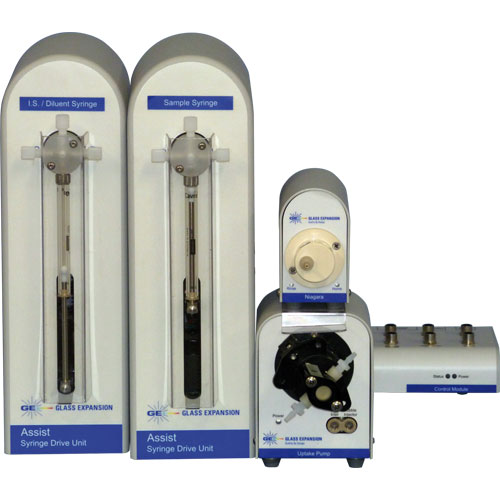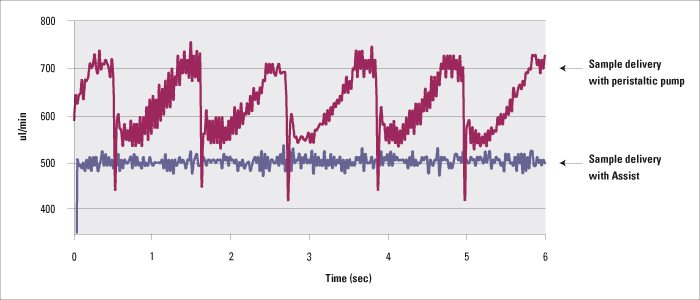The Glass Expansion Assist CM - Dr Khouzami Laborgeräte
The Assist syringe-driven sample introduction system
Assists you with faster throughput
Assists you with improved accuracy
Assists you with better precision
Download the Glass Expansion Assist flyer PDF
View Assist video

The Assist is an automated sample introduction system for ICP-OES or ICP-MS. It consists of purpose-built programmable syringe drives with an integrated valve system. The Assist delivers the highest level of accuracy, stability and sample throughput by controlling the delivery of both sample and internal standard or diluent, eliminating the inaccuracies and pulsations caused by peristaltic pumps. The Assist provides you with:
Twice the sample throughput. The rinse time, stabilization time and the time for the sample to move from the autosampler to the nebulizer are all reduced. This reduces the time for a typical analysis by at least half.
Better precision. The sample is delivered by a precisely controlled syringe, eliminating the signal pulsation problem which occurs with the usual peristaltic pump delivery system.
Better accuracy. The internal standard is delivered by a second precision syringe drive, ensuring that the ratio of internal standard to sample is accurately maintained. The fluctuations in this ratio that occur when the internal standard is delivered by peristaltic pump are eliminated, greatly improving the analytical accuracy.
Automatic dilution. The second syringe drive can also be used to deliver a diluent, enabling accurate dilution by a factor of up to 20:1 to be carried out automatically.
Reduced carryover. The sample does not contact any peristaltic pump tubing and the sample path is totally inert. This allows for a faster rinse and reduces carryover.
Low sample and internal standard usage. The volumes required are substantially reduced, resulting in lower cost of reagents and less wastage.
Flexibility in the selection of the ratio of sample to internal standard. The syringe system allows you to use sample to internal standard ratios of up to 20:1 and still get accurate correction.
Longer life of consumables. The lower sample volume and reduced analysis time mean that you save on consumables such as torches and ICP-MS cones as well as argon.
Compatibility. The Assist software is configured to operate with almost all models of ICP-MS, ICP-OES and autosampler.

Configured to suit your application
The Assist is a modular system of syringe drives and switching valves and it can be configured to suit specific applications.
Premium Package. This is the most common system and is the system described above. It incorporates two syringe drives and a Niagara switching valve. It provides for the inline delivery and mixing of the sample and internal standard or diluent.
Download PITTCON paper: Characteristics of a Syringe Driven Sample Introduction Accessory for ICP Spectrometry
Download PITTCON paper: Advantages of a syringe driven sample introduction accessory for ICP spectrometry
Download FACSS slide: Can you increase ICP Productivity and performance at the same time?
Basic Package. This system is used when inline delivery of internal standard or diluent is not required. It incorporates a single syringe drive and a Niagara switching valve. It provides all of the benefits listed above with the exception of those relating to delivery of internal standard or diluent.
Oils Package. This system is configured specifically for the analysis of wear metals in raw (undiluted) lubricating oils. It incorporates three syringe drives and a Niagara switching valve. It takes a sample of the oil, mixes it with a diluent such as kerosene and precisely delivers the diluted oil to the ICP spectrometer. It eliminates the need for manual dilutions and increases the speed of analysis.
Download newsletter: Comparison of Enhanced Productivity ICP Approaches for Engine Oil Analysis
Download PITTCON paper: Enhanced Productivity ICP (EP-ICP) for Tribology Applications
New Control Module
The new Assist CM is controlled by a dedicated control module rather than the instrument PC. The benefits are:
- Faster communication, resulting in even higher sample throughput.
- The option of running unattended without any connection to the instrument PC once the method has been loaded.
- Simplified installation.
